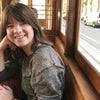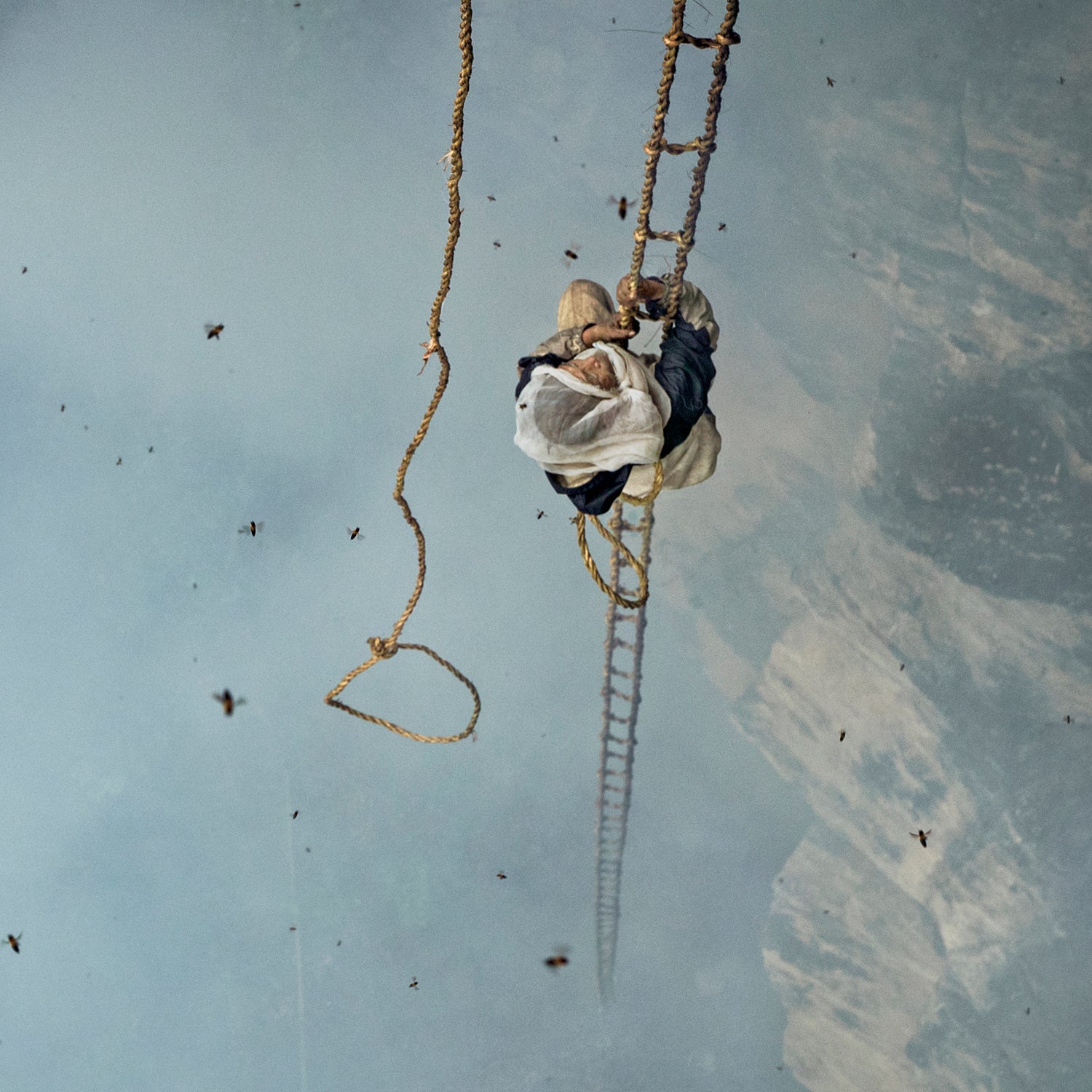Picture the most terrifying scenario you can think of. Did you imagine scaling a sheer cliff, the ground far below cloaked in fog, only to be greeted by hundreds of the largest honeybees in the world, and you have only a small piece of mesh for protection? If you did, you either have some pretty specific fears or caught the world premiere of The Last Honey Hunter at the recent Telluride Mountainfilm Festival. Starting in 2016, producer Ben Ayers worked with filmmakers Renan Ozturk and Ben Knight to tell the story of Mauli Dhan Rai, a 58-year-old man who has performed this exact feat since he was directed to do so in a dream at age 16. He and a team of assistants harvest the honeycomb and poisonous honey, which has hallucinogenic effects and has become lucrative for its believed medicinal benefits in other Asian countries.
Ayers stumbled upon the honey hunters eight years ago through his work as Nepal country director with the . This was his first film production, “and it just went huge,” Ayers says. It shows in the documentary, which is lush, meticulous, and (anecdotally) an audience favorite at Mountainfilm. You can read about the expedition and see more of Ozturk’s photography in the . The documentary will get a wide release sometime by early 2018. In the meantime, Ayers took us through the filmmaking process—leeches, vengeful forest spirits, and all.
On Finding the Last Honey Hunter
“For the Kulung, the ethnic group that lives in Saadi, for them to be able to go onto the cliff and touch the honeycomb and the honey, you have to be selected by this wrathful forest spirit called Rongkemi through a special dream. And Mauli Dhan was the last person in the village to have this dream. There’s a very specific narrative dream you have to have about being stuck in a spider’s web on the cliff, and you’re rescued by this large white monkey. So he told his father and the village elders about the dream, and they said, ‘You’re the one. You’re the honey harvester.’
“Through these last years of friendship with Mauli Dhan, I kept pestering him: ‘Can we make a movie? Can we come out and take pictures?’ It was like, ‘No, no, no, no, no.’ And finally he was like, ‘Fine, you can come with me, but this is the last time it’s gonna be done.’”
On Wrathful Forest Spirits
“Basically the Kulung culture and language only exists in three villages in this remote valley, and it’s a very intricate shamanistic, animistic culture. The way that they relate to the river, the fields, the forests all has to do with this pantheon of spirits that exists sort of outside of what we would call reality. And the shamans are the mediums that go between the spirit world and our world. There’s a power to this place and this culture that is difficult to describe without sounding like a total Froot Loop, but we felt it.
“There was this weird thing that happened when we all basically had to call in Rongkemi to bless us so it wouldn’t harm us while we were on the cliffs. We’re inside of this sacred enclosure in the middle of the forest, and chickens are dying and people are shouting and cymbals are clashing and the shaman is channeling the spirit and speaking in tongues—and the electronics all stopped working when the spirit showed up. I’m sounding like a total nutjob here, but it happened. And Ben [Knight] steps out of the sacred enclosure, and the electronics work. The Red camera fires back up. He goes back in, and it shuts off. And shit like that was happening, like, every day.”
On Painful Behind-the-Scenes Moments
“It was rugged. We did two different expeditions to film it, and both were really intense in their own ways. We were absurdly fast and light—the fact that Renan only had 17 bags of camera gear was extraordinary. And just getting to where we’d shoot took us three days of driving, three days of hiking, and everybody else got sick, so like, three days of everybody just barfing their brains out. We were getting 50, 60 leeches a day just getting up to the cliffs. Even getting to the top of the cliff was like, 5.10 jungle mountaineering, nasty unprotected climbing. Renan, who climbed Meru, gave his rope to locals, like, ‘Guys, fix this for us. We can’t do it.’
“And then just simply wearing a bee suit 300 feet off the ground, being surrounded by 100,000 of the largest honeybees in the world and discovering that the bee suits don’t work because their stingers were too long. Unfortunately, it was mostly in the face they’d get you. It’s just basically like being murdered by bees. The bee suits worked well enough that we could function, but 15 feet away from us, there’s a guy with no ropes, and at one point he was free-soloing with just a bit of flimsy netting wrapped around his neck.”
On the Risk of Romanticizing the Honey Hunt
“From a visual perspective, the honey harvest is the most impressive thing. But we could make a movie about these guys, like, harvesting firewood and it would be pretty equally badass. Life out there is really hard, and things are really steep. The community in general is very used to taking these kinds of risks that we find absolutely unfathomable.
“I don’t mean to paint it as being too blasé. It’s a big deal, it’s dangerous, and people have died doing it, so there is respect given to the practice. But what’s striking to us, if there was a honey harvesting festival in Telluride, we’d be planning, like, six months in advance for this shit. You’d have the honey-hunting parade! These guys just go Tuesday morning. ‘Time to go, get the ropes out, off we go.’ What was surprising to us was just how mellow they were about the whole process. It’s a big deal, but it’s not the only big deal in their lives.
“Ben [Knight] had the opportunity to make a film that was only badass honey-hunting porn. We had tons of high-angle footage, huge beehives, stuff falling everywhere, and Ben focuses on what’s going on in Mauli Dhan’s head, and the community, the people, and their lives.”
On the Honey Hunter’s Personality
“There was a moment when we were all back in camp, exhausted and miserable, and it’s raining, but we were also feeling pretty proud of ourselves. We were talking to Mauli Dhan, asking him, ‘How many times did you get stung?’ He just looks over at us, and his face is super swollen. He’s obviously hurting. He goes, ‘You saw what I did up there. You know what I’ve done.’ That was his answer. He knew we were trying to idolize him, that we wanted to quantify his awesomeness, and he just was like, you’ve witnessed it, you don’t need to put a number on it.
“Mauli is an amazing character. The internal dialogue that the film highlights is him reflecting on his life and growing older—these very human things that we all worry about. Except I guess you and I don’t worry about our relationship to a wrathful forest spirit. But it’s him wondering about growing old and being upset that he can’t continue this with his own frailty. And that leads him also to think about his relationship to the dream and Rongkemi, and if he’s been given this blessing or this curse. He doesn’t know which it is.”
On the Finished Product
“A big part of what we hope this film will do for the locals is create a sense of pride in the things about their communities that are really special, or at the very least, we’ve documented a lot of it. To my knowledge, we’re one of the only film crews ever to document anything about the Kulung.
“I think honestly Mauli Dhan is probably done harvesting honey. You could see it’s so strenuous, what he goes through. He told us he’s glad that he did those last two harvests and that we were successful with the filming. But he learned in that process that he doesn’t have the physical ability to keep doing it. It’s possible that one of the younger members of the team will have the dream. It’s possible they’ll do it without having the dream. We don’t know. As far as I can predict, we did film the last time that happened.”


